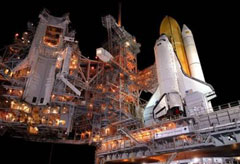 |
| Shuttle Discovery
sits on top of launch pad 39B after making its way from the
Vehicle Assembly Building at the Kennedy Space Center in Cape
Canaveral, Florida, April 7, 2005. (REUTERS/Charles W.
Luzier) | |
Space shuttle Discovery
began its slow creep to the launch
pad Wednesday after a brief delay caused by the discovery
of a crack in the external fuel tank's foam insulation . NASA later said the
crack was no reason for concern.
The flaw was discovered as the spacecraft was being readied for the
first shuttle launch since Columbia fell to pieces two years ago - a
disaster blamed on a chunk of
foam that fell off the tank during liftoff and gashed one of the wings.
NASA spokeswoman Jessica Rye described the flaw as a hairline crack and
said after sending images of it to the tank's manufacturer in Louisiana,
the space agency concluded it did not need to make any repairs.
NASA later said the 1 1/2-inch crack was high up on the shuttle in a
spot where if foam flew off it would not likely hit the vehicle.
NASA then began moving Discovery from its assembly building to the
launch pad, after a delay of at least two hours.
Because of Columbia's disintegration over Texas in 2003 - and the
deaths of all seven astronauts aboard - the tank has been extensively
redesigned for Discovery's flight.
NASA plans a mid-May liftoff with a launch window from mid-May to June
- a period dictated by the position of the international space station,
the shuttle's destination.
Discovery was being moved on a 5.5 million-pound transporter, a huge
platform on caterpillar
tracks, along a specially built road that is almost as
wide as an eight-lane highway. The 4.2-mile journey to the launch pad was
expected to take hours, since the transporter moved at only 1 mph.
The move went smoothly until gauges gave off false indications about
whether the vehicle was level as it climbed a ramp leading to the launch
pad. The transporter was backed up to level ground so workers could
determine if there was a problem with the gauges.
"It's a great sight to see Discovery rolling out to the launch pad,"
shuttle commander Eileen Collins, who will lead the crew on the next
mission, said from Mission Control in Houston. "We know we are getting
close."
(Agencies) |
本周三(4月6日),美國“發現”號航天飛機被緩慢移送到發射臺上,之前因其外部燃料槽的泡沫絕緣材料被發現有一處小裂縫,遷移行動延遲了一小會。美國國家航空與宇航局稍后表示這處裂痕無關緊要。
這處裂痕是在航天飛機正準備進行首次發射時發現的。兩年前,(承載相同任務的)“哥倫比亞”號航天飛機剛一起飛就發生爆炸,裂成碎片。那場災難要歸咎于起飛后一大塊泡沫材料從燃料槽上脫落,撞傷了一側的機翼。
美國國家航空與宇航局發言人杰西卡·雷用“頭發絲一樣的細紋”來形容這一裂痕,并在將裂紋照片傳給路易斯安那的燃料槽生產商后表示,宇航總局認定這點小毛病不需要任何檢修。
美國國家航空與宇航局后來聲明,這道1.5英寸長的裂紋位于航天飛機的頂部,即使泡沫材料從那個位置掉落下來,也不可能砸到飛行器。
然后,美國國家航空與宇航局開始將“發現”號從裝配大樓移送到發射臺,這比原定時間至少推遲了兩小時。
2003年,“哥倫比亞”號在德克薩斯州上空爆炸解體,機上的七名宇航員全部喪生。正因為這一事件,“發現”號的燃料槽經過了徹底的重新設計。
美國國家航空與宇航局計劃在五月中旬發射“發現”號,并將發射時限設定在五月中旬到六月之間,這一時間是根據國際空間站(航天飛機的目的地)的位置設定的。
“發現”號沿著專用坡道被運送到運輸機(一個放在運輸履帶上的巨型平臺)上,那條坡道差不多有八條高速路行車道那么寬。這趟4.2英里的旅程預計要花數小時,因為運輸機重達550萬磅,時速僅為每小時一英里。
搬移工作進展很順利,除了當運輸機攀爬上通往發射臺的坡道時,測量儀器對車身的水平狀態發出了錯誤的指示。運輸車不得不退回到平地上,以便工作人員們檢查測量儀器是否出現故障。
“看到‘發現’號終于爬上了發射臺,這真是一幅壯觀的景象。”航天飛機指揮官艾琳·柯林斯在休斯頓的任務控制處說,“我們知道自己離目標不遠了。”柯林斯將率領全體工作人員完成下一次飛行任務。
(中國日報網站譯) |
